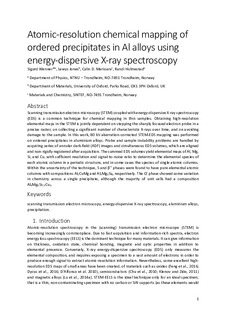Atomic-resolution chemical mapping of ordered precipitates in Al alloys using energy-dispersive X-ray spectroscopy
Journal article
Submitted version
Permanent lenke
http://hdl.handle.net/11250/2476051Utgivelsesdato
2017Metadata
Vis full innførselSamlinger
- Institutt for fysikk [2653]
- Publikasjoner fra CRIStin - NTNU [37219]
Sammendrag
Scanning transmission electron microscopy (STEM) coupled with energy-dispersive X-ray spectroscopy (EDS) is a common technique for chemical mapping in thin samples. Obtaining high-resolution elemental maps in the STEM is jointly dependent on stepping the sharply focused electron probe in a precise raster, on collecting a significant number of characteristic X-rays over time, and on avoiding damage to the sample. In this work, 80 kV aberration-corrected STEM-EDS mapping was performed on ordered precipitates in aluminium alloys. Probe and sample instability problems are handled by acquiring series of annular dark-field (ADF) images and simultaneous EDS volumes, which are aligned and non-rigidly registered after acquisition. The summed EDS volumes yield elemental maps of Al, Mg, Si, and Cu, with sufficient resolution and signal-to-noise ratio to determine the elemental species of each atomic column in a periodic structure, and in some cases the species of single atomic columns. Within the uncertainty of the technique, S and β” phases were found to have pure elemental atomic columns with compositions Al2CuMg and Al2Mg5Si4, respectively. The Q’ phase showed some variation in chemistry across a single precipitate, although the majority of unit cells had a composition Al6Mg6Si7.2Cu2.
